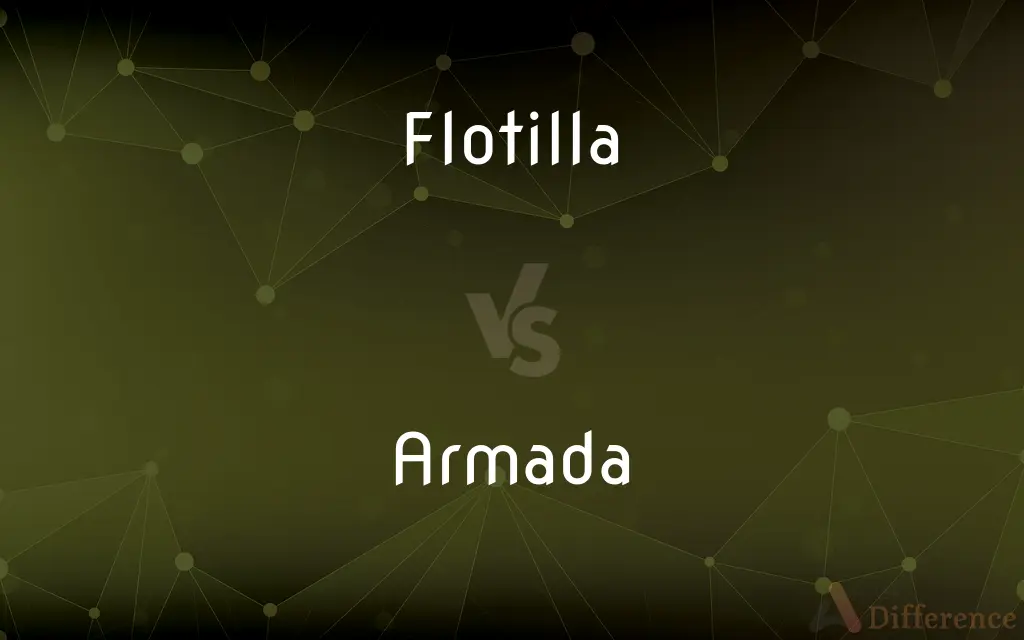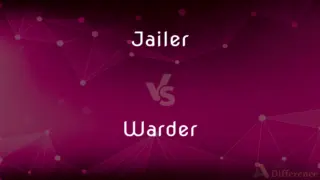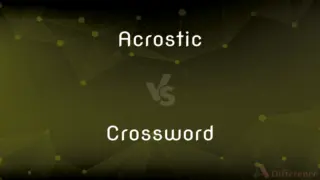Flotilla vs. Armada — What's the Difference?
By Tayyaba Rehman & Maham Liaqat — Updated on March 19, 2024
A flotilla is a small group of ships, often part of a larger fleet, used for naval operations, while an armada is a large fleet of ships, typically organized for major naval warfare.

Difference Between Flotilla and Armada
Table of Contents
ADVERTISEMENT
Key Differences
A flotilla refers to a relatively small group of ships, usually part of a larger naval force, designed for specific tasks such as patrol, escort, or minor naval engagements. In contrast, an armada represents a much larger and more formidable fleet, often comprising numerous ships of various types, organized for significant naval campaigns or battles.
Flotillas are often employed for specialized operations, such as mine-sweeping, anti-submarine warfare, or coastal defense, requiring agility and specific tactical capabilities. On the other hand, an armada is typically assembled for major offensive or defensive naval actions, involving broader strategic objectives and encompassing a wide array of naval power, including aircraft carriers, destroyers, and support vessels.
While the term "flotilla" suggests a more tactical and flexible approach to naval operations, focusing on specific missions or regions, "armada" implies a strategic, large-scale deployment intended for decisive engagements or showing formidable naval strength.
The organizational structure within a flotilla is generally more streamlined and focused, with ships working closely together under a unified command to achieve specific objectives. Conversely, an armada requires complex coordination and logistics, often involving multiple flotillas and support units, to effectively manage its diverse and extensive capabilities.
In historical contexts, flotillas have played crucial roles in local naval operations and support roles within larger fleets, while armadas have been central to significant naval battles and campaigns, shaping the outcomes of wars and the balance of naval power.
ADVERTISEMENT
Comparison Chart
Size
Small group of ships.
Large fleet of ships.
Purpose
Specialized naval operations, support tasks.
Major naval warfare, strategic deployments.
Composition
Often includes similar types of ships for specific tasks.
Diverse types of ships for comprehensive naval capabilities.
Flexibility
High, designed for specific, often localized missions.
Less flexible, intended for large-scale operations.
Historical Significance
Crucial in local engagements and as part of larger fleets.
Central to major naval battles and campaigns.
Compare with Definitions
Flotilla
Small naval group.
The navy dispatched a flotilla for coastal patrol duties.
Armada
Large naval force.
The Spanish Armada of 1588 was a massive fleet intended to invade England.
Flotilla
Part of a larger fleet.
The flotilla played a support role within the broader naval operation.
Armada
Strategic military objectives.
The armada was assembled for a decisive battle against the enemy.
Flotilla
Specialized operations.
A flotilla of minesweepers was deployed to clear the channel.
Armada
Diverse ship composition.
The armada included aircraft carriers, destroyers, and support vessels.
Flotilla
Tactical flexibility.
The flotilla quickly adapted to the changing conditions at sea.
Armada
Historic naval engagements.
The armada's defeat marked a turning point in naval warfare.
Flotilla
Streamlined command.
The flotilla commander efficiently coordinated the group's maneuvers.
Armada
Complex logistics and coordination.
Coordinating the movements of the armada required meticulous planning.
Flotilla
A flotilla (from Spanish, meaning a small flota (fleet) of ships), or naval flotilla, is a formation of small warships that may be part of a larger fleet.
Armada
A fleet of warships.
Flotilla
A small fleet.
Armada
A fleet of warships, especially with reference to the Spanish Armada.
Flotilla
A fleet of small craft.
Armada
A large group of moving things
An armada of ants crossing the lawn.
Flotilla
A naval unit consisting of two or more squadrons of small warships.
Armada
Any large army or fleet of military vessels.
Flotilla
(Informal) A group of vehicles owned or operated as a unit
A flotilla of limousines.
Armada
A large flock of anything.
An armada of insects attacked us every day at sunset.
Flotilla
(nautical) A small fleet of warships (usually of the same class), or a fleet of small ships.
Armada
A fleet of armed ships; a squadron. Specifically, the Spanish fleet which was sent to assail England, a. d. 1558.
Flotilla
A little fleet, or a fleet of small vessels.
Armada
A large fleet
Flotilla
A United States Navy fleet consisting of two or more squadrons of small warships
Flotilla
A fleet of small craft
Common Curiosities
What is the purpose of an armada?
An armada serves the purpose of engaging in major naval warfare or strategic military operations, showcasing significant naval power.
Can a flotilla operate independently?
While flotillas can operate independently, they are often part of larger naval operations and might work in conjunction with other naval forces.
How does the size of a flotilla compare to an armada?
A flotilla is much smaller in size compared to an armada, which comprises a large number of ships.
What defines a flotilla?
A flotilla is defined as a small group of ships, often part of a larger fleet, organized for specific naval tasks or operations.
How is command structured in a flotilla vs. an armada?
Flotillas have a streamlined command structure focused on specific objectives, whereas armadas require complex coordination and a hierarchical command for diverse operations.
What types of ships are found in an armada?
An armada includes a wide variety of ships, such as aircraft carriers, destroyers, frigates, and support vessels, to fulfill comprehensive naval capabilities.
What historical impact have armadas had?
Armadas have played significant roles in naval history, often determining the outcomes of pivotal naval battles and shaping maritime dominance.
Can a flotilla include different types of ships?
Flotillas typically consist of similar types of ships suited to specific tasks, but they can include different types if the mission requires varied capabilities.
How do modern navies incorporate the concept of an armada?
Modern navies may assemble armada-like forces for significant military operations or exercises, utilizing advanced naval technologies.
Are flotillas used in modern navies?
Yes, modern navies use flotillas for various specialized tasks such as surveillance, mine-sweeping, and anti-submarine warfare.
Can an armada be part of a larger naval force?
An armada is typically the main naval force in a campaign, though it may operate alongside other military units or coalitions.
How do historical and modern armadas differ?
Modern armadas differ from historical ones in terms of technology, strategy, and the nature of naval warfare, with modern armadas utilizing advanced technology and integrated naval systems.
How does the tactical use of flotillas differ from armadas?
Flotillas are used for more tactical, focused missions, whereas armadas are deployed for broader, strategic purposes.
What role do flotillas play in coastal defense?
Flotillas are essential in coastal defense for patrolling, quick response, and engaging in localized maritime threats.
What logistics challenges do armadas face?
Armadas face substantial logistics challenges, including supply, maintenance, and coordination, due to their size and the complexity of operations.
Share Your Discovery

Previous Comparison
Jailer vs. Warder
Next Comparison
Acrostic vs. CrosswordAuthor Spotlight
Written by
Tayyaba RehmanTayyaba Rehman is a distinguished writer, currently serving as a primary contributor to askdifference.com. As a researcher in semantics and etymology, Tayyaba's passion for the complexity of languages and their distinctions has found a perfect home on the platform. Tayyaba delves into the intricacies of language, distinguishing between commonly confused words and phrases, thereby providing clarity for readers worldwide.
Co-written by
Maham Liaqat














































